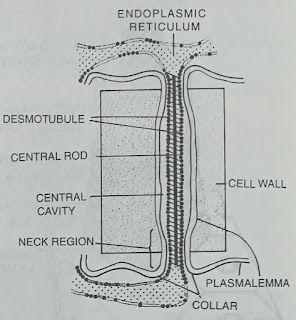Formation of secondary wall materials on the primary wall does not take place uniformly, instead some thin areas are left out-those thin areas are called pit-fields. Thin and delicate strands or fibrils of cytoplasm, called plasmodesmata (singular : plasmodesma), pass through such pit-fields of the cell wall at intervals, thus connecting the living protoplasts of adjacent cells. Plasmodesmata usually occur in groups but they may be evenly distributed over the entire wall. When they are grouped they are localised In the primary pit-fields.
Most of the plasmodesmata are found to be restricted In thin areas (the primary pit-fields) of the young walls ; on the other hand, in mature walls with secondary layers, plasmodesmata sometimes occur in large groups only in the pit-membrane.
 |
| Two views regarding the structure of plasmodesmata |
Secondary plasmodesmata may form between more mature cells which have not undergone division (e.g. in cells of carpels and other organs) or between the haustoria of some parasites and the cells of their host plants.
The distribution and number of plasmodesmata per unit area are determined during cell division.
Plasmodesmata may be quite numerous and meristematic cells may have plasmodesmata between 1000-100,000.
 |
| Diagram of a plasmodesmata as seen under electron microscope |
Plasmodesmata have been also observed in the cell walls with the help ofdelectron microscope. The endoplasmic reticulum has been seen to contact with the plasmodesmata, thus forming a membrane system that can link nuclei of adjacent cells. Some workers think that tubules of endoplasmic reticulum extend through the plasmodesmata (Whaley et al 1960), although the connection between the elements of the reticulum through a plasmodesmata appears as solid structure. Plasmodesmata are cytoplasmic in nature-this can be proved by the fact that they are present only in living cells, they stain like that of cytoplasm, they exhibit a positive reaction for oxidases, on plasmolysis the protoplast withdraws from the wall in all portions except where plasmodesmata are present.
Plasmodesmata are found in red algae, mosses, liverworts, pteridophytes. gymnosperms and angiosperms. They may be seen throughout all living tissues including the meristematic.
Plasmodesmata, occurring in the outer walls of epidermal cells, are termed ectodesmata (Sievers, 1959 ; Franke, 1961).
Plasmodesmata can be observed readily traversing the thick cell walls of the endosperm of certain seeds e.g. Phoenix sp., Coffea arabica, Diospyros sp., Aesculus sp., Strychnos nux-vomica etc.
Practically, plasmodesmata are narrow channels through the cell wall, they are bounded by plasmalemma and containing cytoplasm and often a desmotubule. The desmotubule i.e. the central core, when present, is composed of protein sub-units and is a modified membranous structure which is continuous with the endoplasmic reticulum of the adjoining cells. Many workers think that the desmotubule is a derivative of the endoplasmic reticulum. Plasmodesmata are small, and upto 60 nm in diameter, normally organelles cannot pass through them (Gunning, 1976 : Robards, 1975-76).
Probable functions of Plasmodesmata :
(i) Plasmodesmata are mainly concerned with the translocation of food, specially in storage tissue like endosperm.
(ii) Plasmodesmata are concerned with the conduction of external and internal stimuli through plant tissues.
(iii) In some cases they establish union of isolated protoplasts of the plant body into a single protoplasmic structure.
(iv) Sometimes plasmodesmata are regarded as additonal layers for mechanical support.
(v) Plasmodesmata are regarded as channels for the movement of viruses from cell to cell (Esau, 1965).
(vi) It has been thought that most plant hormones move through the plasmodesmata (Carr, 1976).
Origin : Regarding the origin and development of plasmodesmata.
Foster (1949) writes that “additional secondary protoplasmic connections may arise during the development of elongating fibres and ramifying sclereids. in such cases, portions of the cell establish new cell contacts by “gliding” or"‘intrusive" growth between neighbouring elements. and during this phase new plasmodesmata may originate."
The origin and development of plasmodesmata has been studied by Frey-Wyssling (1959).
According to him the cell plate is partly protoplasmic in nature although its real nature is unknown. It is assumed that young growing walls are penetrated by the cytoplasm. With the accumulation of the cellulose microfibrils and pectic substances in the wall. the cytoplasmic connections become narrower gradually until they constitute thin threads i.e. the plasmodesmata. Some authors (Buvat and Pulssant, 1958) suggest that plasmodesmata are already present in the cell plate at the time of cell division. Generally with the increase of the wall surface the number of plasmodesmata also increases, this is probably brought about by the splitting of the original threads. When new areas of contact are formed between the cells during expansion of tissues, intrusive growth etc.. new plasmodesmata are formed in the maturing cell wall. According to Jones (1976), plasmodesmata are formed during cytokinesis, apparently at sites in the cell plate where strands of endoplasmic reticulum prevent fusion of vesicles.


nice information..i was really looking for this article...thanks dear
ReplyDeletewww.thezoology.xyz